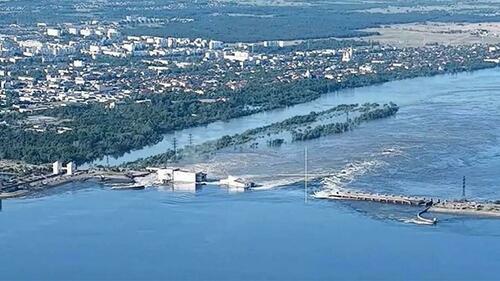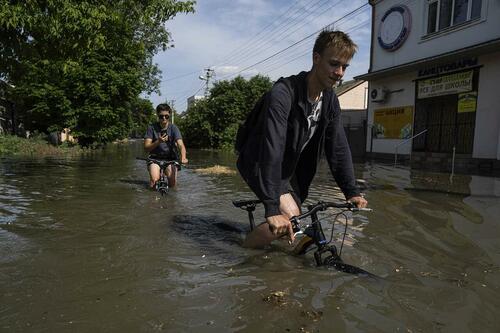Ukraine Nuclear Plant Safe For Now, IAEA Says, After Kakhovka Dam Collapse
Following yesterday’s Kakhovka dam explosion and as flooding continues to wreak disaster for towns and villages downstream in Ukraine’s south, the International Atomic Energy Agency (IAEA) is assuring Ukraine and the world that the dam break is posing “no short-term risk” to Europe’s biggest atomic plant.
While falling water levels have been observed in a reservoir used to cool the reactors for the Russian-occupied Zaporizhzhia nuclear power station, the late Tuesday IAEA statement cited “no short-term risk to nuclear safety and security.”
The Zaporizhzhia plant sits some 150 kilometers, or 90 miles upstream of the dam on the on the Dnipro River. The ‘no immediate risk’ assessment is also based on the facility having “back-up options available,” according to the IAEA as cited in AFP.
Ukrainian leaders while trying to lay quick blame on Russia, which the Kremlin has rejected, asserted Tuesday that the world “once again finds itself on the brink of a nuclear disaster” – according to the words of presidential aide to Zelensky, Mykhaylo Podolyak. Local authorities estimate that some 42,000 residents are at risk and in the flooding disaster zone.
“The water went up in an instant,” said one resident downstream. “In the morning there was nothing.”
IAEA chief Rafael Grossi has painted a picture of the dam breakage being very concerning but not unmanageable for Europe’s largest nuclear power plant:
Water levels were dropping by nine centimeters (3.5 inches) per hour in the reservoir above the dam, up from five centimeters early on Tuesday, IAEA head Rafael Grossi said in a statement.
Water in the reservoir was at around 15.44 meters late Tuesday, he added. When the level drops below 12.7 meters, then water can no longer be pumped to the plant, Grossi warned.
“As the full extent of the damage to the dam is not yet known, and the water loss rate is fluctuating, it is not possible to predict exactly when this might happen,” Grossi said, adding that the key level “could be reached in the next couple of days.”
Video showing the flooding and devastation in Russian-occupied Oleshky, Kherson oblast, a day after the Kakhovka Dam under Russian forces’ control was destroyed. pic.twitter.com/k6ys9rnjij
— Christopher Miller (@ChristopherJM) June 7, 2023
But, Grossi emphasized, the plant operators already have experience of implementing fail-safe backup procedures throughout the war thus far, and the reactors have already been shut down – yet they still need cooling water to prevent nuclear meltdown.
According to more of Grossi’s words via AFP:
Existing water at the plant in cooling ponds and elsewhere can then still be used “for some time” to cool the reactors and the spent fuel pools in the reactor buildings, Grossi added.
Additionally, a large cooling pond next to the site is “currently full and has enough in storage to supply the plant for several months as its six reactors are in shutdown mode,” Grossi said.
“It is therefore vital that this cooling pond remains intact… I call on all sides to ensure nothing is done to undermine that,” Grossi told a meeting of the agency’s board of governors, adding he will visit the plant next week.
The plant can also access a deep water-filled excavation in its cargo port area, as well as the water system of the nearby city of Enerhodar and use mobile pumps and firefighter trucks to fetch water.
Plant staff have already implemented measures to limit the consumption of water, using it only for “essential nuclear-safety related activities.”
“There is a preparedness for events like this (the dam being damaged)… But clearly, this is making an already very difficult and unpredictable nuclear safety and security situation even more so,” Grossi said.
…”Absence of cooling water in the essential cooling water systems for an extended period of time would cause fuel melt and inoperability of the emergency diesel generators,” Grossi warned.
All of this means that the situation is worsening but there is still “time” to look for solutions, according to authorities overseeing the plant.
Kherson. Hundreds of residential buildings flooded. pic.twitter.com/NB2jeCdN0X
— NEXTA (@nexta_tv) June 7, 2023
Meanwhile, many thousands in the region impacted by the Kakhovka dam collapse continue to be evacuated, and international media reports have said there’s likely an unknown number of casualties from the rising flood waters.
Ukrainian officials have predicted that by Thursday water levels of the Dnipro will rise another 3 feet, and will engulf more areas downstream along the banks. Kherson oblast could see flooding for at least another ten days. Area residents’ access to clean drinking water is also being impacted.
Tyler Durden
Wed, 06/07/2023 – 09:55
via ZeroHedge News https://ift.tt/FlM5X9v Tyler Durden

